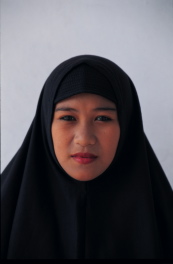
Prague, 8 April 2004 (RFE/RL) — When Basma El Shayyal began wearing an Islamic head scarf to her Roman Catholic school, teachers asked her to take it off. Eventually, El Shayyal and her parents persuaded the teachers it wasn’t just a passing phase, and the teachers relented.
That was some years ago. Since then, El Shayyal says, British attitudes to the hijab have become more accepting. “Attitudes are changing, they’re maybe becoming more polarized, but in the middle spectrum they’re becoming a lot more, not just tolerant but accepting,” she says. “Examples of that are for instance the recent attitude to uniforms — particularly in the [London] Metropolitan police force, where they’ve recently incorporated it as part of the uniform should a Muslim lady wish to take that up as an option.”
In Western countries with large Muslim minorities, official attitudes to the head scarf vary from restrictive to supportive. If Britain is at one extreme, at the opposite end of the spectrum may be France, where head scarves and other overt religious symbols will be banned from public schools as of September. It’s all in the name of protecting France’s strict secularist principles against what some see as a particularly assertive brand of Islam.
The ban has prompted large street protests. But it has many supporters — including Rachida Ziouche, an Algerian-born journalist who writes for Clara, a French women’s rights magazine. “I say it’s important that the law banning head scarves should be applied,” she says. “It’s necessary to counter the actions of the Islamists. Things can’t be dictated by religion. It’s not religion that dictates the law of a country.”
Behind the ban is the longstanding principle that religion should be kept out of the public sphere. A long history of battles between church and state has led many people in France to see secularism as the best way to guarantee national unity and peace.
Other countries too have constitutions that separate religion and state. But none guard the separation so strenuously as France. That may explain why recent moves to curb the hijab in Germany have taken a different form. Last week, Baden-Wuerttemberg became the first federal state in Germany to bring in an anti-head-scarf law. Other parts of Germany have similar laws in the pipeline.
The difference there is that the ban in Baden-Wuerttemberg applies to state school teachers, not students. And it forbids only the head scarf, not other religious symbols.
Matthias Rohe, an expert on Islam and the law at Germany’s Erlangen University, tells RFE/RL: “Some people fear that the head scarves would be a symbol of a certain Islamic politics, that it could be more than a religious command to wear it. That’s why some states in Germany are going to forbid this kind of symbol…. We say even if some people are suspicious concerning the head scarf, [the] pupil, the student is not a part of the German government or administration, so their right to exercise religious freedom, or their parents’ right to decide that, is stronger than the fears of the surrounding society. So we distinguish between state officials on the one hand and everybody else on the other.”
Another country grappling with the head scarf issue is the United States. There, a schoolgirl in Oklahoma was recently banned for wearing the hijab because the school didn’t allow headwear of any sort. But last week the U.S. Justice Department intervened on her behalf, arguing she shouldn’t have to choose between her religion and her education.
Shireen Hunter is the head of the Islamic program at Washington’s Center for Strategic Studies. She says: “The U.S. constitution is not antireligion, as opposed to the extreme secularism in France, where secularism has almost turned into an intolerant religion itself, a sort of intolerant dogma. That’s one thing. In America, religion and politics are separate but religion does have a place in the public space. After all, we say, ‘One nation indivisible under God’…. Consequently, some peaceful expressions of faith, including one’s attire, are not viewed as illegal or having political connotations.”
The Council on American-Islamic Relations, a Washington-based organization that seeks to promote positive views of Islam and Muslims in the United States, said the U.S. intervention in support of head scarves sends a message to other countries about religious freedoms.
The difference in approach was noticed in France, says Farhad Khosrokhavar, a professor at Paris’s School for Advanced Social Science Studies. But Khosrokhavar says the two cases arise from different systems and cannot be compared.
As for the French ban, Khosrokhavar says it is likely to backfire and lead to a more fragmented society. “It’s a way of giving an imaginary mythical homogeneity of French society to those who are in the state sponsored educational system…. At the same time, French society needs that feeling of cultural homogeneity, which is more fictitious than real, but it gives them some sense of nationhood,” he says. “I don’t think in real life it will change too much, and in reaction to this ban many women might be induced to wear it more ostentatiously than before.”
As for schoolgirls, he says those who can afford it will go to where the scarf is allowed — the country’s Catholic schools.
(RFE/RL correspondent Breffni O’Rourke contributed to this report.)
© 2004. RFE/RL, Inc. – Reprinted with the permission of Radio Free Europe/Radio Liberty, 1201 Connecticut Ave., N.W. Washington DC 20036. Website: www.rferl.org